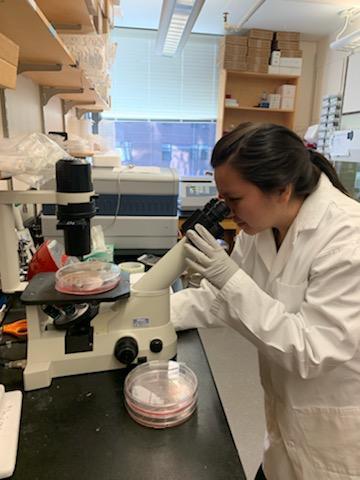HUNAP Conference Grant Helps GSAS Research Scholar Fellow Attend ABCRMS
HUNAP provides funding to members of the Harvard community for various opportunities such as grants to offset the cost of attending professional conferences. Alanna Pyke (Mohawk), recently received a grant to attend ABRCMS, a major STEM-oriented conference, held in Anaheim, CA in October, 2019.
Recently, I was able to travel to the Annual Biomedical Research Conference for Minority Students (ABRCMS) by the generosity of the Harvard University Native American Program. The conference is a meeting place for undergraduates, post-baccalaureate students (like me), graduate students, post-doctoral researchers, faculty and graduate admission officers. Much of the conference, and most of my personal focus, was the exhibit hall. The exhibit hall was filled with hundreds of graduate school recruitment booths (at least three from Harvard alone), and student poster presentations.
ABRCMS also had numerous sessions in a dozen disciplines across science. From disparities in skin cancer to diversity in microbiota, each session was tailored to minority students. The one I attended on skin cancer was interesting because it talked about the importance for people with darker skin to wear sunscreen and take protective measures against the sun’s harmful rays. Although it is much less likely for people with darker skin to be diagnosed with skin cancer, they are much more frequently diagnosed with later stage and more aggressive types of skin cancer. In addition, the session also explained the importance of caffeine in reducing one’s risk for skin cancer. In particular, those that drink one cup of coffee per day had a 5% reduced risk to get skin cancer.
Another session I attended was led by Dr. Kathryn Milligan-Myhre, an Inupiaq scientist who grew up above the arctic circle in what is currently known as Alaska. I was deeply moved by her introduction, when she introduced herself in her Native language. This was the first time that I have ever attended a major scientific conference and heard a Native language as a part of a talk. She also took a moment to acknowledge the land we were on and the people that were there first. Once that was finished, she took a moment to acknowledge the victims of the shooting that happened in Santa Clarita earlier that day. This was an all too rare moment of acknowledging our humanity in the midst of a scientific meeting.
Dr. Milligan-Myhre’s talk was fantastic, as she described her work in microbiology at the University of Alaska Anchorage. Specifically, she studies the microbiota of stickleback fish, a small fish which is often the prey of salmon in Alaska. One of her recent research projects investigates how oil spills affect the microbiome of stickleback fish, and whether or not the fish were more prone to illness or other symptoms. After her talk, I introduced myself and am looking forward to connecting with her at a later date.
The rest of the conference was rather uneventful, as Dr. Milligan-Myhre was the only Native speaker at the conference. I attended other talks about the graduate school application process, how to apply to government-funded grants, and talks about breast cancer. I was grateful for the opportunity to attend the conference since I had the chance to connect with current PhD students in the exhibit hall, which helped me find things that I value in my graduate school experience and answered my questions about the application process. Overall, the conference reaffirmed my interest in science and raised my confidence about continuing my path in science.

Alanna is completing her post-bac fellowship at the Dana Farber Institute while at Harvard
Funding for Harvard students and scholars is available every semester. Please email hunap@harvard.edu for more info on deadlines and an application.

